Animals with strange names!
 As
promised a couple of weeks back, we introduce you to some interesting
creatures from the animal kingdom today. They include animals from the
Bovidae family, which is the largest and most diverse family of mammals
with about 215 species, antelope , bovines and also the smelliest
animal, not only in the animal world, but on Earth! As
promised a couple of weeks back, we introduce you to some interesting
creatures from the animal kingdom today. They include animals from the
Bovidae family, which is the largest and most diverse family of mammals
with about 215 species, antelope , bovines and also the smelliest
animal, not only in the animal world, but on Earth!
Animals are a part of our
environment and the more we learn about their habitats, behaviour and
habits, the easier it would be for us to understand them and protect
them. So, take time to explore the world of animals whenever you can.
Chamois - climber of mountain peaks
A goat-like animal belonging to the family of Bovidae, it is native
to the European Alps, but is also found in the Balkans, parts of Turkey,
the Caucasious mountain range and South island of New Zealand. It lives
at moderately high altitudes.
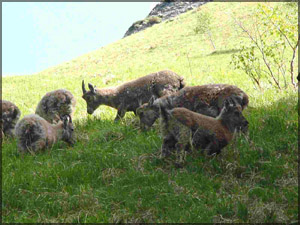 There
are two species in the genus. It is a protected species as it is hunted
for its skin. Chamois leather was very much in demand in many parts of
the world at one time. There
are two species in the genus. It is a protected species as it is hunted
for its skin. Chamois leather was very much in demand in many parts of
the world at one time.
The chamois reaches a height of 75 cm (2 1/2 ft) and weighs about to
50 kg (110 pounds). Both males and females have short horns which are
slightly curled in the backward direction.
It has a summer and winter coat; the fur turns a rich brown colour in
the summer and a light grey in the winter. The fur on the face and the
rump is white. There are pronounced white stripes on the coat and a
black dorsal (on the back) stripe. It also has a black stripe running
from the eye to mussle. A slight mane is visible around the throat.
The short, smooth summer coat has guard hairs which are about 10-20
cm long and cover a wooly underlay.
The chamois is adapted to living in steep, rugged rockey terrain and
its climbing abilities are surpassed only by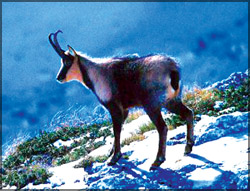 the Alpine ibex. The females and young or the kids live in herds, but
the males live solitary lives for most of the year. The kids are fully
grown by 3 years. The kids can follow their mothers almost immediately
after birth.
the Alpine ibex. The females and young or the kids live in herds, but
the males live solitary lives for most of the year. The kids are fully
grown by 3 years. The kids can follow their mothers almost immediately
after birth.
The chamois is extremely sure-footed. The sole of the hoof is
slightly hollow and soft, so this gives it a better grip on slippery
surfaces. It spends the summer near the snow line in the mountain chains
from the Alps to the Carpathians. It descends to lower altitudes only in
the winter.
When the snow cover becomes too deep and the chamois cannot find
food, it fasts for two weeks or more, without any ill effects. It eats
herbs, flowers, lichens and mosses.
Its agility on the mountain face is legendary. It can easily jump
over obstacles as high as 13 feet when pursued by a predator.
Zorilla, the smelliest animal on
earth
A derivative of the Spanish word 'Zorro' which means pole, the
zorilla belongs to the mamalian group and is certainly not a cat. In
Sudan it's called 'Father of stinks'.
This skunk-like mammal lives in the African savannahs and is commonly
placed with the skunk family, but is related to the weasel. It is a
solitary, nocturnal animal which can be spotted mostly at sundown or
dawn. When frightened, it scuttles to its burrows among the rocks. It
lives mostly in its burrow during daytime and goes in search of food at
night. It sometimes lives in burrows dug by other creatures.
Its fur coat is long and soft, but dense. Its mostly black and white
in colour. In fact, the three or four large
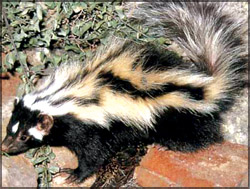 white
stripes on the black body has earned it the name 'the striped pole cat.' white
stripes on the black body has earned it the name 'the striped pole cat.'
It has conspicuous(clearly visible) white marks on the face and a
thick, bushy while tail with black bands. It is often mistaken for the
American skunk. The zorilla which is about 11-15 inches in length with a
12 inch tail weighs around three pounds.
Its snout is long, legs are short and feet have sturdy claws. It has
a springy short trot. It can stalk animals.
It's a carnivorous animal eating rodents, birds, snakes and hares. It
also eats seeds, fruits and insects especially when food is scarce.The
zorilla has highly developed scent glands. It can propel the strong
smell a long distance, like most other American skunks.
The young are born with short fur, but the stripes are already
visible. The female gives birth to a litter of 2-3 young. When
confronted by a predator, it can not only eject the foul-smelling
secretion from its scent glands, but also pretend to be dead like an
opossum.
Sitatunga - the spectacular aquatic
antelope
The sitatunga, also known as the marshbuck or the swamp-dwelling
antelope, is found throughout central and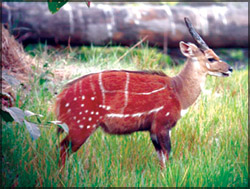 western Africa. It is considered to be the only true amphibious
antelope, and is distinguished by its unique structure of long and
widely splayed(spread apart) hooves and loose foot joints. These
features make the animal somewhat clumsy on dry land.
western Africa. It is considered to be the only true amphibious
antelope, and is distinguished by its unique structure of long and
widely splayed(spread apart) hooves and loose foot joints. These
features make the animal somewhat clumsy on dry land.
Essentially a solitary animal, the sitatunga lives in thickly
vegetated, muddy swamps and marshes. The situtunga is a good swimmer,
and can move with surprising grace and speed through the swamps. It
usually stays half-submerged in the water, with only a part of its head
or sometimes only the tip of its nostrils above the water. When
disturbed or threatened, it can dive deeper into the water and hide
among the reeds.
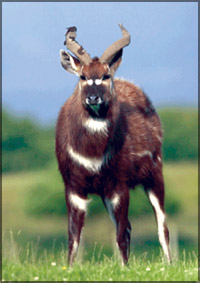 It
is both nocturnal and diurnal, but is most active at dawn and dusk. Its
diet consists of bullrushes, leaves of bushes in the swamp, grass from
adjacent land and fallen fruits. It also chews on bark of some trees and
bushes. It
is both nocturnal and diurnal, but is most active at dawn and dusk. Its
diet consists of bullrushes, leaves of bushes in the swamp, grass from
adjacent land and fallen fruits. It also chews on bark of some trees and
bushes.
The sitatunga is about 36.6-45 inches in height at the shoulders. It
has a shaggy, oily coat adaptable to the aquatic habitat it lives in.
The males' coat is a greyish brown and the females' is a reddish
chocolate colour. It's branded with 6-8 vertical white stripes. The male
is larger than the female and has long, twisting horns which grow up to
about 45-90 cm (18-36 inches).
The sitatunga's elongated hooves and flexible foot joints enable it
to walk easily on soft ground without sinking. Generally, a sitatunga
can live up to 20 years. The female gives birth to a single young after
a gestation period of 250 days.
Kilspringer - the unique antelope
walking on tiptoes
In Africaans, the name means 'rock jumper'. Unique among antelopes,
the kilspringer is a small, stocky,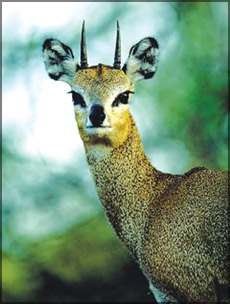 powerful, and agile creature. It is also very shy and nervous. It is
about 20-22 inches high at the shoulder and weighs around 30-40 pounds.
powerful, and agile creature. It is also very shy and nervous. It is
about 20-22 inches high at the shoulder and weighs around 30-40 pounds.
Except for one East African race, only the males have horns. The
male's horns are rather delicate, but what's unusual is that the ears
are longer than the horns. On average, the horns are about four inches
long. Its thick, dense coat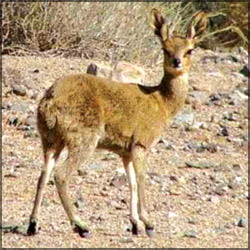 of coarse, grizzled fur has a special 'salt and pepper' pattern and is
almost olive shaded. The eyes are large and widely spaced. The nose is
short and wedge shaped. Horns are wideset and upstanding like spikes.
of coarse, grizzled fur has a special 'salt and pepper' pattern and is
almost olive shaded. The eyes are large and widely spaced. The nose is
short and wedge shaped. Horns are wideset and upstanding like spikes.
Usually, all hoofed animals walk on the tips of their toes, but this
hoofed creature touches ground with the very tips of its vertically
rising hoofs. Talking in human terms, it is like dancing on toe nails
rather than on the tip of the toes. Amazingly, the unique construction
of the hoof makes it possible for it to climb up practically vertical
outcrops and balance on the sharpest ridges.
Found mostly in the Cape of Good Hope region in Africa and in East
Africa, right into Ethiopia, the kilspringer's unique feature is its
ability to bring its front and hind legs together into one spot when
standing still. In fact, its feet are so small that all of its hooves
can easily fit on an American dime at one time.
The kilspringer runs in jerky movements. When disturbed by predators,
it bounds off, leaping from crag to crag and looks almost as if it's
flying.
It is monogamous and usually stays close to its mate in pairs. The
males are territorial. Females are usually larger than the males. A
single fawn is born after three months.
You may be surprised to learn that it never drinks water! As its diet
consists of succulent rock plants, it usually absorbs all the water it
needs from these plants or by licking the dew from leaves, in the early
morning. Kilspringer feeds at dawn and dusk and feeds on leaves and
flowers of various herbs, fruits and shrubs. When food is not available
at reachable levels, it stands on its hind legs to get at it.
Yak - the high-altitude beast of
burden
The yak or grunting ox is a close relative of our own domestic
cattle. It roams the mountains of the Himalaya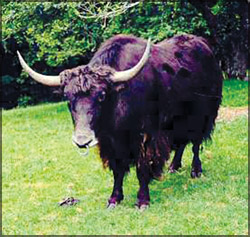 and the Tibetan plateau. It shows a marked preference for the moorlands
up to 6100 m (20,000 ft) in altitude.
and the Tibetan plateau. It shows a marked preference for the moorlands
up to 6100 m (20,000 ft) in altitude.
This long-haired and humped bovine is massive, weighing about 37.4-46
lbs. It is about 24 inches high at the shoulder. Despite its size, it is
surprisingly able to manoeuvre itself on rocks and climb well.
Both the wild and domesticated yak have long, shaggy hair to keep it
insulated from the cold. Its hair inside is matted and the matting is
possible due to a sticky secretion in its sweat. This secretion is used
as medicine by the people of Nepal. Both gender have horns. In winter,
the yak could survive temperatures as low as 40 degrees Celsius because
of its long, matted fur. The fibre from its coat is used to spin yarn
for knitting.
As the yak is docile and can be easily tamed, it has been
domesticated. In fact, it has been serving man for over 4000 years, not
only as a beast of burden, but also as a producer of milk and wool. The
yak's milk is rich in butter fat.
It is also killed for its meat. The domestic variety is somewhat
smaller than the wild species. The female gives birth to a single calf
which becomes independent after about a year. The yak can live up to 32
years. It feeds in the morning and evening, mostly on grass and also
lichens and plants. |
